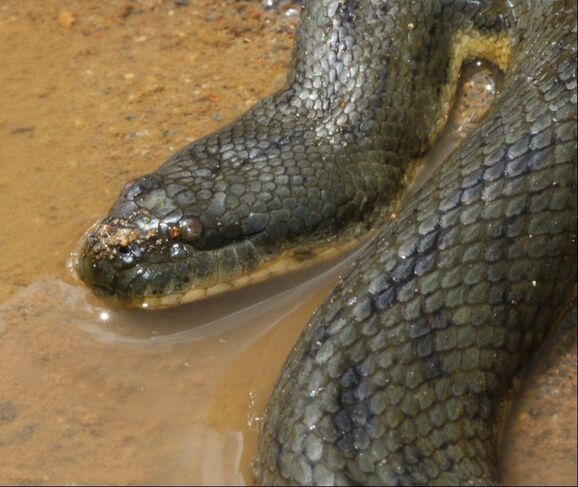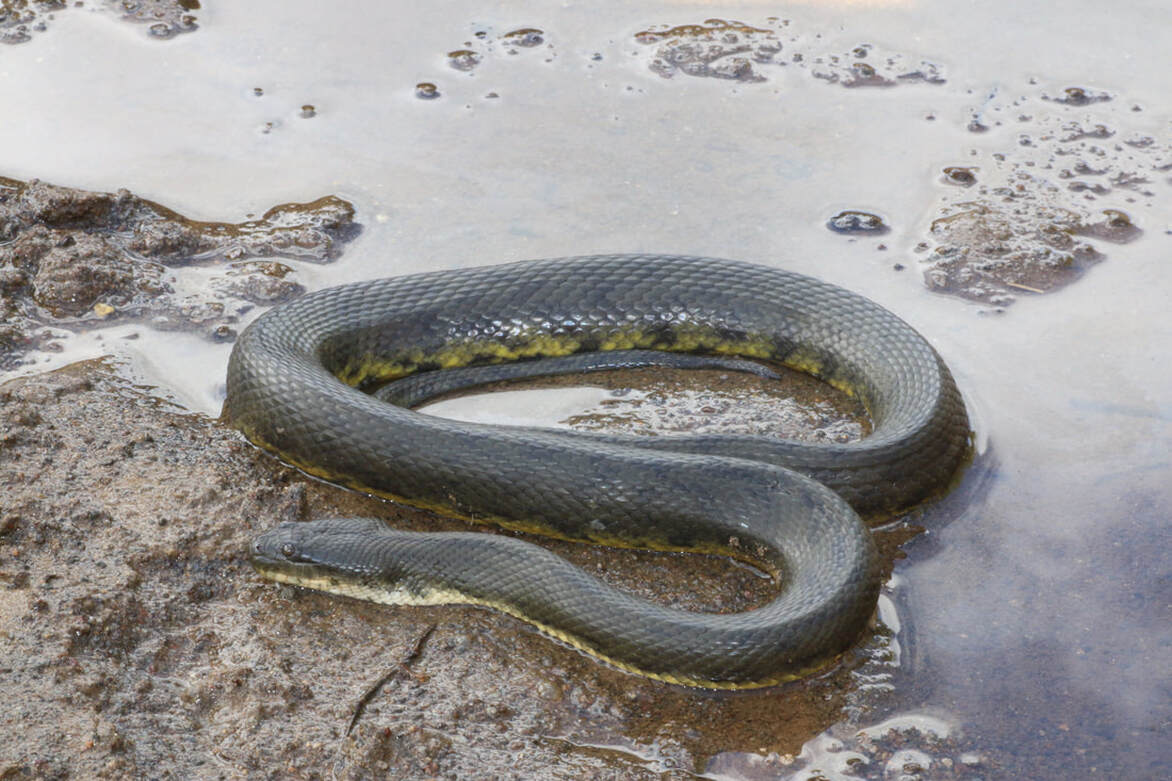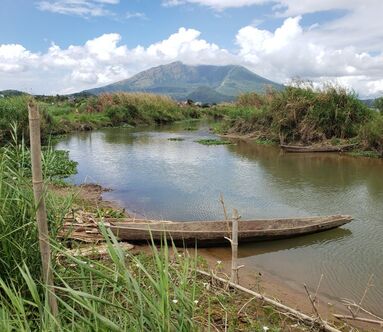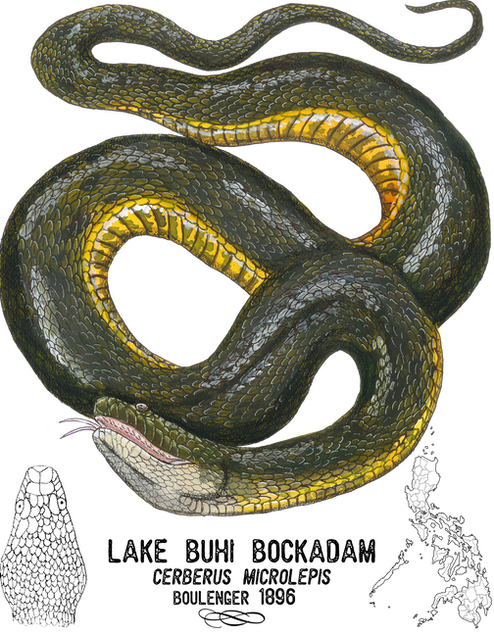The Lake Buhi Bockadam survey Project
FUNDED IN PART BY THE HCI HAROLD K. Voris grant
ABOUT HOMALOPSIDAE
Rich in diversity around the world, snakes play a vital role in their respective ecosystems by controlling predator and prey population levels. In particular, the large number of aquatic snake species represent a fascinating system that showcases the successful adaptation of snakes to aquatic habitats. Many families of snakes have adapted to marine, riverine, or lake systems, with homalopsid snakes (‘mud snakes’) being one of the most abundant groups found through South and Southeast Asia, and northern Australasia. Only recently have large-scale studies of homalopsid snakes been conducted, aiming to identify the biogeographic correlates to their evolutionary success and current diversity. However, many species, especially narrowly distributed taxa, remain to be studied, and their natural history, behavior, diets, and roles they play in their restricted ecosystems are unknown.
Rich in diversity around the world, snakes play a vital role in their respective ecosystems by controlling predator and prey population levels. In particular, the large number of aquatic snake species represent a fascinating system that showcases the successful adaptation of snakes to aquatic habitats. Many families of snakes have adapted to marine, riverine, or lake systems, with homalopsid snakes (‘mud snakes’) being one of the most abundant groups found through South and Southeast Asia, and northern Australasia. Only recently have large-scale studies of homalopsid snakes been conducted, aiming to identify the biogeographic correlates to their evolutionary success and current diversity. However, many species, especially narrowly distributed taxa, remain to be studied, and their natural history, behavior, diets, and roles they play in their restricted ecosystems are unknown.
 Photo by Justin Bernstein
Photo by Justin Bernstein
THE LAKE BUHI BOCKADAM
(Cerberus microlepis)
The Philippines is home to over 140 species of snakes, many of which are endemic. The homalopsid snake, Cerberus microlepis, is an endangered species with one of the smallest geographic distributions of any reptile in the world, restricted to the freshwater Lake Buhi (area = ~6.6 km2) in the province of Camarines Sur on Luzon Island. Lake Buhi, and the river systems it is connected to, contain a variety of fish populations (prey) and suitable habitat for C. microlepis, but investigations into the extent C. microlepis migrates out of the lake is unknown, as is how river systems play a role in the sustainability of this species’ population levels. Thus, it is critical to determine if the lake endemic C. microlepis are leaving the Lake Buhi and if there is gene flow, which is vital for populations to be more resistant to environmental change, with populations of Cerberus in the adjacent rivers.
(Cerberus microlepis)
The Philippines is home to over 140 species of snakes, many of which are endemic. The homalopsid snake, Cerberus microlepis, is an endangered species with one of the smallest geographic distributions of any reptile in the world, restricted to the freshwater Lake Buhi (area = ~6.6 km2) in the province of Camarines Sur on Luzon Island. Lake Buhi, and the river systems it is connected to, contain a variety of fish populations (prey) and suitable habitat for C. microlepis, but investigations into the extent C. microlepis migrates out of the lake is unknown, as is how river systems play a role in the sustainability of this species’ population levels. Thus, it is critical to determine if the lake endemic C. microlepis are leaving the Lake Buhi and if there is gene flow, which is vital for populations to be more resistant to environmental change, with populations of Cerberus in the adjacent rivers.
 Photo by Justin Bernstein
Photo by Justin Bernstein
THE PROJECT
In this project, a collaborative effort with those from the United States and the Philippines, we aim to (i) identify the true distribution of C. microlepis both in and out of the lake, (ii) investigate their evolutionary relationships, and (iii) assess the levels of gene flow between populations in and outside of the lake using genome-scale DNA sequence data and quantitative landscape (riverscape) genomic analyses. While river systems are often thought of as barriers to gene flow between populations, they can act as highways of migration and gene flow for aquatic populations. To understand the importance of not just Lake Buhi, but also the surrounding rivers, to the stability of C. microlepis, as well as how Cerberus populations help sustain the ecologically and economically valuable fish populations in this region, these first steps of disentangling the relationships of the geographic landscape and population genomics are of utmost value.
In this project, a collaborative effort with those from the United States and the Philippines, we aim to (i) identify the true distribution of C. microlepis both in and out of the lake, (ii) investigate their evolutionary relationships, and (iii) assess the levels of gene flow between populations in and outside of the lake using genome-scale DNA sequence data and quantitative landscape (riverscape) genomic analyses. While river systems are often thought of as barriers to gene flow between populations, they can act as highways of migration and gene flow for aquatic populations. To understand the importance of not just Lake Buhi, but also the surrounding rivers, to the stability of C. microlepis, as well as how Cerberus populations help sustain the ecologically and economically valuable fish populations in this region, these first steps of disentangling the relationships of the geographic landscape and population genomics are of utmost value.

THE MANDATE
The IUCN Red Data index lists Cerberus microlepis as endangered and decreasing due to logging, wood harvesting, fishing, and use as a human resource as well as pollution threats from urban and domestic waste water. Their direct guidance for conservation is, "This is a very poorly known species, and further studies on its ecology, abundance, and range are urgently needed.
There have been no detailed studies on this species since the early 1990s. Therefore, Herpetological Conservation International has decided to award the first Harold K. Voris Grant to Justin Bernstein.
The IUCN Red Data index lists Cerberus microlepis as endangered and decreasing due to logging, wood harvesting, fishing, and use as a human resource as well as pollution threats from urban and domestic waste water. Their direct guidance for conservation is, "This is a very poorly known species, and further studies on its ecology, abundance, and range are urgently needed.
There have been no detailed studies on this species since the early 1990s. Therefore, Herpetological Conservation International has decided to award the first Harold K. Voris Grant to Justin Bernstein.
THE TEAM
Led by Dr. Justin M. Bernstein, this project's team is comprised of an international collaboration between several institutions in the United States and the Philippines.
|
Dr. Justin M. Bernstein
University of Kansas Center for Genomics Kansas, USA Dr. Michael Clores
Partido State University Camarines Sur, Philippines Mr. Joward Bautista
Partido State University Camarines Sur, Philippines |
Dr. Sara Ruane
Field Museum of Natural History Illinois, USA Dr. Michael Cuesta
Ateneo de Naga University Camarines Sur, Philippines |
Dr. Marites Bonachita Sanguila
Father Saturnino Urios University Agusan del Norte, Philippines Dr. Rafe M. Brown
University of Kansas Biodiversity Institute and Natural History Museum Kansas, USA |




